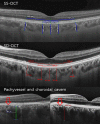Comparison of choroidal thickness measurements using swept source and spectral domain optical coherence tomography in pachychoroid diseases
- PMID: 32101541
- PMCID: PMC7043756
- DOI: 10.1371/journal.pone.0229134
Comparison of choroidal thickness measurements using swept source and spectral domain optical coherence tomography in pachychoroid diseases
Abstract
Purpose: To determine the comparability of choroidal thickness (ChT) measurements using swept source (SS) and spectral domain (SD) optical coherence tomography (OCT) devices in patients with pachychoroid diseases.
Methods: Patients with pachychoroid diseases were recruited. OCT scans were performed sequentially with a Cirrus HD OCT 5000 and Plex Elite 9000. Images were analyzed by two independent observers. Each image was independently measured twice by each observer to determine the intraobserver repeatability.
Results: A total of 55 eyes were included. The average ChT of the subfoveal area using SS-OCT and SD-OCT was 430.5 ± 68.1 and 428.5 ± 57.9 μm, respectively, which did not show a significant result as the main effect in the repeated-measure analysis of variance (P = 0.067). Using SS-OCT, the intraobserver intraclass correlation coefficient (ICC) of both observers was > 0.950 at every measured point, and the interobserver coefficient of repeatability (CR) of the subfoveal area was 45.1 μm (95% confidence interval (CI), 40.8-49.4). Using SD-OCT, the intraobserver ICC of both observers was > 0.800, and the interobserver CR of the subfoveal area was 71.2 μm (95% CI, 64.4-78.0). Additionally, the intraobserver and interobserver CRs showed significantly better repeatability in SS-OCT than SD-OCT in F-test. In patients with ChT ≥ 400 μm, the interobserver CRs of SS-OCT and SD-OCT were 48.4 (95% CI, 42.6-54.2) and 95.2 μm (95% CI, 83.9-106.6), respectively. In patients with a subfoveal active lesion, the interobserver CRs were 44.5 (95% CI, 37.6-51.4) and 100.1 μm (95% CI, 84.6-115.5), respectively.
Conclusions: Although the ChT measurements were comparable between SS-OCT and SD-OCT devices in pachychoroid diseases, SD-OCT showed low reliability in patients with ChT ≥ 400 μm and subfoveal active lesions. SS-OCT would be therefore more suitable for observation and follow-up of choroidal structures in pachychoroid diseases.
Conflict of interest statement
NO authors have competing interests.
Figures




Similar articles
-
Comparison of choroidal thickness measurements between spectral domain optical coherence tomography and swept source optical coherence tomography in children.Sci Rep. 2021 Jul 2;11(1):13749. doi: 10.1038/s41598-021-92980-9. Sci Rep. 2021. PMID: 34215790 Free PMC article.
-
Comparison of choroidal thicknesses using swept source and spectral domain optical coherence tomography in diseased and normal eyes.Br J Ophthalmol. 2015 Mar;99(3):354-8. doi: 10.1136/bjophthalmol-2014-305331. Epub 2014 Oct 1. Br J Ophthalmol. 2015. PMID: 25273828
-
Direct comparison of spectral-domain and swept-source OCT in the measurement of choroidal thickness in normal eyes.Br J Ophthalmol. 2014 Mar;98(3):334-8. doi: 10.1136/bjophthalmol-2013-303904. Epub 2013 Nov 28. Br J Ophthalmol. 2014. PMID: 24288394
-
Swept-source optical coherence tomography imaging of the retinochoroid and beyond.Expert Rev Med Devices. 2020 May;17(5):413-426. doi: 10.1080/17434440.2020.1755256. Epub 2020 Apr 20. Expert Rev Med Devices. 2020. PMID: 32275451 Review.
-
Evaluation of Choroidal Thickness Using Optical Coherent Tomography: A Review.Front Med (Lausanne). 2021 Dec 3;8:783519. doi: 10.3389/fmed.2021.783519. eCollection 2021. Front Med (Lausanne). 2021. PMID: 34926529 Free PMC article. Review.
Cited by
-
Clustering of eyes with age-related macular degeneration or pachychoroid spectrum diseases based on choroidal thickness profile.Sci Rep. 2021 Mar 2;11(1):4999. doi: 10.1038/s41598-021-84650-7. Sci Rep. 2021. PMID: 33654225 Free PMC article. Clinical Trial.
-
Choroid and choriocapillaris changes in early-stage Parkinson's disease: a swept-source optical coherence tomography angiography-based cross-sectional study.Alzheimers Res Ther. 2022 Aug 25;14(1):116. doi: 10.1186/s13195-022-01054-z. Alzheimers Res Ther. 2022. PMID: 36008844 Free PMC article.
-
Short-term effect of anti-VEGF for chronic central serous chorioretinopathy according to the presence of choroidal neovascularization using optical coherence tomography angiography.PLoS One. 2021 Jan 11;16(1):e0245342. doi: 10.1371/journal.pone.0245342. eCollection 2021. PLoS One. 2021. PMID: 33428683 Free PMC article.
-
Choroidal Neovascularization Is Common in Best Vitelliform Macular Dystrophy and Plays a Role in Vitelliform Lesion Evolution.Ophthalmol Retina. 2023 May;7(5):441-449. doi: 10.1016/j.oret.2022.11.014. Epub 2022 Dec 14. Ophthalmol Retina. 2023. PMID: 36528270 Free PMC article.
-
Potential Drug Targets for Diabetic Retinopathy Identified Through Mendelian Randomization Analysis.Transl Vis Sci Technol. 2024 Nov 4;13(11):17. doi: 10.1167/tvst.13.11.17. Transl Vis Sci Technol. 2024. PMID: 39541108 Free PMC article.

